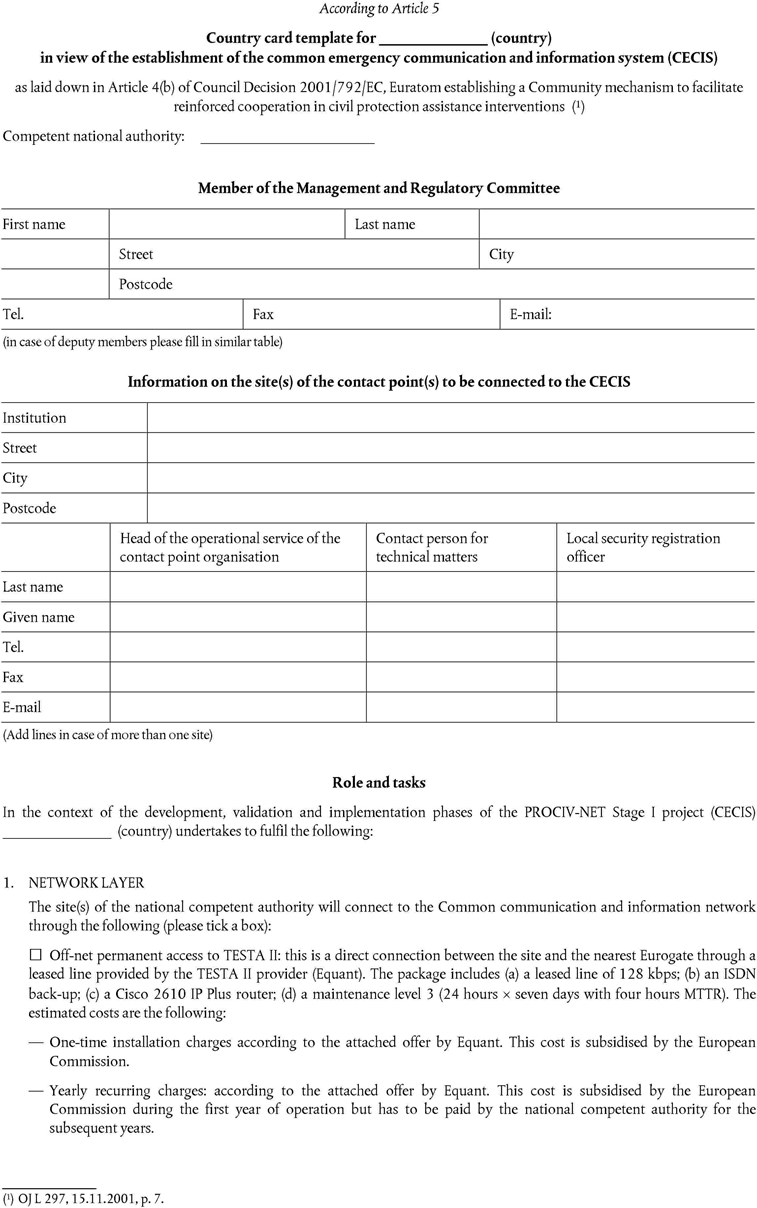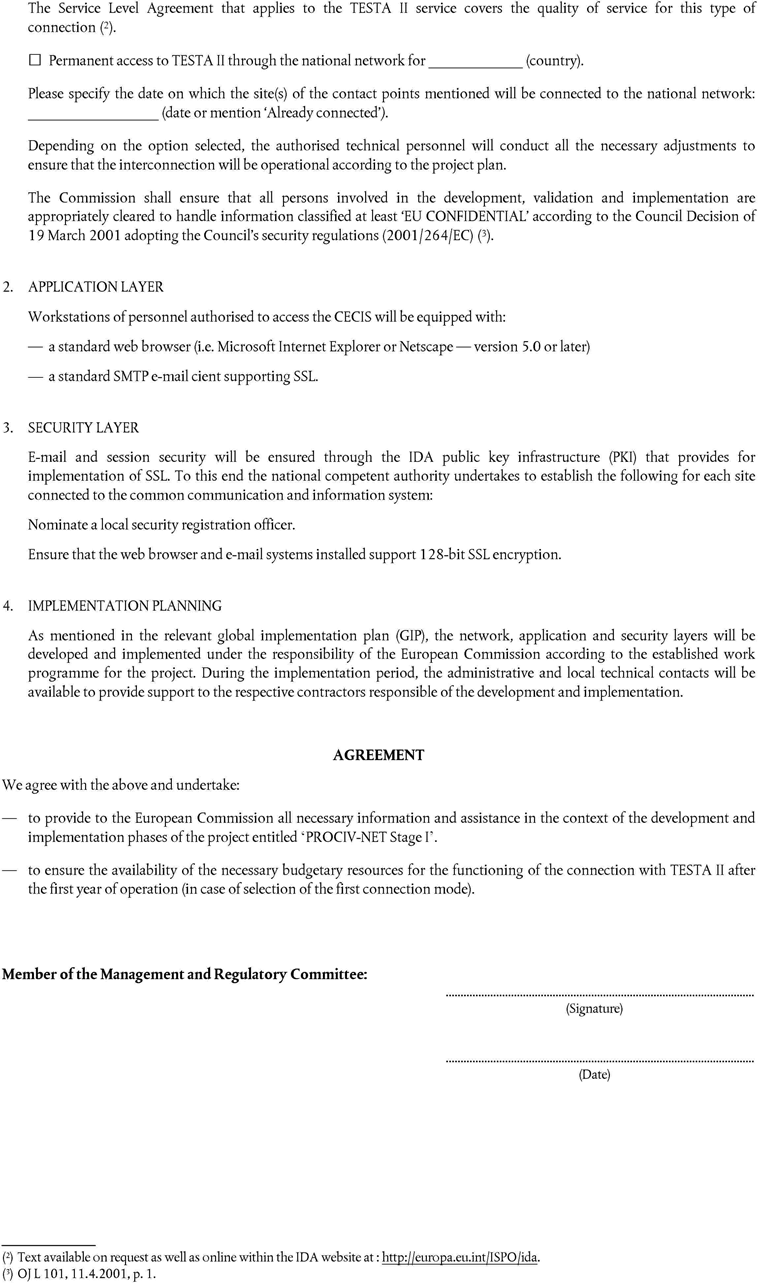- Latest available (Revised)
- Point in Time (24/01/2008)
- Original (As adopted by EU)
Commission Decision of 29 December 2003 laying down rules for the implementation of Council Decision 2001/792/EC, Euratom establishing a Community mechanism to facilitate reinforced cooperation in civil protection assistance interventions (notified under document number C(2003) 5185) (Text with EEA relevance) (2004/277/EC, Euratom)
You are here:
- Decisions originating from the EU
- 2004 No. 277
- Annexes only
- Show Geographical Extent(e.g. England, Wales, Scotland and Northern Ireland)
- Show Timeline of Changes
More Resources
Revised version PDFs
- Revised 07/09/20100.37 MB
- Revised 24/01/20080.17 MB
This is a legislation item that originated from the EU
After exit day there will be three versions of this legislation to consult for different purposes. The legislation.gov.uk version is the version that applies in the UK. The EU Version currently on EUR-lex is the version that currently applies in the EU i.e you may need this if you operate a business in the EU.
The web archive version is the official version of this legislation item as it stood on exit day before being published to legislation.gov.uk and any subsequent UK changes and effects applied. The web archive also captured associated case law and other language formats from EUR-Lex.
Changes over time for: Commission Decision of 29 December 2003 laying down rules for the implementation of Council Decision 2001/792/EC, Euratom establishing a Community mechanism to facilitate reinforced cooperation in civil protection assistance interventions (notified under document number C(2003) 5185) (Text with EEA relevance) (2004/277/EC, Euratom) (Annexes only)
Version Superseded: 07/09/2010
Alternative versions:
Status:
Point in time view as at 24/01/2008.
Changes to legislation:
There are currently no known outstanding effects for the Commission Decision of 29 December 2003 laying down rules for the implementation of Council Decision 2001/792/EC, Euratom establishing a Community mechanism to facilitate reinforced cooperation in civil protection assistance interventions (notified under document number C(2003) 5185) (Text with EEA relevance) (2004/277/EC, Euratom).![]()
Changes to Legislation
Revised legislation carried on this site may not be fully up to date. At the current time any known changes or effects made by subsequent legislation have been applied to the text of the legislation you are viewing by the editorial team. Please see ‘Frequently Asked Questions’ for details regarding the timescales for which new effects are identified and recorded on this site.
[F1ANNEX I] U.K.
Textual Amendments
F1 Substituted by Commission Decision of 20 December 2007 amending Decision 2004/277/EC, Euratom as regards rules for the implementation of Council Decision 2007/779/EC, Euratom establishing a Community civil protection mechanism (notified under document number C(2007) 6464) (Text with EEA relevance) (2008/73/EC, Euratom).
[F2ANNEX II U.K. General requirements for European civil protection modules (1)
Textual Amendments
F2 Inserted by Commission Decision of 20 December 2007 amending Decision 2004/277/EC, Euratom as regards rules for the implementation of Council Decision 2007/779/EC, Euratom establishing a Community civil protection mechanism (notified under document number C(2007) 6464) (Text with EEA relevance) (2008/73/EC, Euratom).
1.
High capacity pumping
| Tasks |
|
| Capacities |
|
| Main components |
|
| Self-sufficiency |
|
| Deployment |
|
2.
Water purification
| Tasks |
|
| Capacities |
|
| Main components |
|
| Self-sufficiency |
|
| Deployment |
|
3.
Medium urban search and rescue
| a Live casualty. | |
| b Basic capacity, more extensive capacities are included in the ‘ chemical, biological, radiological and nuclear detection and sampling ’ module. | |
| c Patient care (first aid and medical stabilisation) from victim access to victim handover. | |
| Tasks |
|
| Capacities |
|
| Main components |
|
| Self-sufficiency |
|
| Deployment |
|
4.
Heavy urban search and rescue
| a Live casualty. | |
| b Basic capacity, more extensive capacities are included in the ‘ chemical, biological, radiological and nuclear detection and sampling ’ module. | |
| c Patient care (first aid and medical stabilisation) from victim access to victim handover. | |
| d Subject to medical and veterinary licensing terms. | |
| Tasks |
|
| Capacities |
|
| Main components |
|
| Self-sufficiency |
|
| Deployment |
|
5.
Aerial forest fire fighting module using helicopters
| Tasks |
|
| Capacities |
|
| Main components |
|
| Self-sufficiency |
|
| Deployment |
|
6.
Aerial forest fire fighting module using airplanes
| Tasks |
|
| Capacities |
|
| Main components |
|
| Self-sufficiency |
|
| Deployment |
|
7.
Advanced medical post
| Tasks |
|
| Capacities |
|
| Main components |
|
| Self-sufficiency |
|
| Deployment |
|
8.
Advanced medical post with surgery
| Tasks |
|
| Capacities |
|
| Main components |
|
| Self-sufficiency |
|
| Deployment |
|
9.
Field hospital
| Tasks |
|
| Capacities |
|
| Main components |
|
| Self-sufficiency |
|
| Deployment |
|
10.
Medical aerial evacuation of disaster victims
| Tasks |
|
| Capacities |
|
| Main components |
|
| Self-sufficiency |
|
| Deployment |
|
11.
Emergency temporary shelter
| Tasks |
|
| Capacities |
|
| Main components |
|
| Self-sufficiency |
|
| Deployment |
|
12.
Chemical, biological, radiological and nuclear detection and sampling (CBRN)
| a This process should, where possible, take account of the evidential requirements of the requesting state. | |
| Tasks |
|
| Capacities |
|
| Main components |
|
| Self-sufficiency |
|
| Deployment |
|
13.
Search and rescue in CBRN conditions
| Tasks |
|
| Capacities |
|
| Main components |
|
| Self-sufficiency |
|
| Deployment |
|
[F2ANNEX III U.K.
General requirements for Technical Assistance Support Teams
| Tasks |
|
| Capacities |
|
| Main components |
|
| Deployment |
|
[F2The list of civil protection modules and the related requirements established in this Decision may be amended to include other types of civil protection modules taking into account the experience gained by the Mechanism.]
Textual Amendments
F2 Inserted by Commission Decision of 20 December 2007 amending Decision 2004/277/EC, Euratom as regards rules for the implementation of Council Decision 2007/779/EC, Euratom establishing a Community civil protection mechanism (notified under document number C(2007) 6464) (Text with EEA relevance) (2008/73/EC, Euratom).
Options/Help
Print Options
PrintThe Whole Decision
PrintThe Annexes only
Legislation is available in different versions:
Latest Available (revised):The latest available updated version of the legislation incorporating changes made by subsequent legislation and applied by our editorial team. Changes we have not yet applied to the text, can be found in the ‘Changes to Legislation’ area.
Original (As adopted by EU): The original version of the legislation as it stood when it was first adopted in the EU. No changes have been applied to the text.
Point in Time: This becomes available after navigating to view revised legislation as it stood at a certain point in time via Advanced Features > Show Timeline of Changes or via a point in time advanced search.
See additional information alongside the content
Geographical Extent: Indicates the geographical area that this provision applies to. For further information see ‘Frequently Asked Questions’.
Show Timeline of Changes: See how this legislation has or could change over time. Turning this feature on will show extra navigation options to go to these specific points in time. Return to the latest available version by using the controls above in the What Version box.
More Resources
Access essential accompanying documents and information for this legislation item from this tab. Dependent on the legislation item being viewed this may include:
- the original print PDF of the as adopted version that was used for the EU Official Journal
- lists of changes made by and/or affecting this legislation item
- all formats of all associated documents
- correction slips
- links to related legislation and further information resources
Timeline of Changes
This timeline shows the different versions taken from EUR-Lex before exit day and during the implementation period as well as any subsequent versions created after the implementation period as a result of changes made by UK legislation.
The dates for the EU versions are taken from the document dates on EUR-Lex and may not always coincide with when the changes came into force for the document.
For any versions created after the implementation period as a result of changes made by UK legislation the date will coincide with the earliest date on which the change (e.g an insertion, a repeal or a substitution) that was applied came into force. For further information see our guide to revised legislation on Understanding Legislation.
More Resources
Use this menu to access essential accompanying documents and information for this legislation item. Dependent on the legislation item being viewed this may include:
- the original print PDF of the as adopted version that was used for the print copy
- correction slips
Click 'View More' or select 'More Resources' tab for additional information including:
- lists of changes made by and/or affecting this legislation item
- confers power and blanket amendment details
- all formats of all associated documents
- links to related legislation and further information resources



